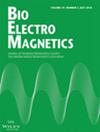Gernot Schmid, Pia Schneeweiss, Rene Hirtl, Johannes Kainz, Cornelia Sauter, Heidi Danker-Hopfe, Hans Dorn
求助PDF
{"title":"研究50hz磁场对睡眠和阿尔茨海默病标志物可能影响的全身暴露装置的设计和剂量学分析","authors":"Gernot Schmid, Pia Schneeweiss, Rene Hirtl, Johannes Kainz, Cornelia Sauter, Heidi Danker-Hopfe, Hans Dorn","doi":"10.1002/bem.70022","DOIUrl":null,"url":null,"abstract":"<div>\n \n <p>A new whole-body exposure facility for a randomized, double-blind, cross-over provocation study investigating possible effects of 50 Hz magnetic field exposure on sleep and markers of Alzheimer's disease has been developed and dosimetrically analyzed. The exposure facility was custom-tailored for the sleep laboratory where the study was carried out and enables magnetic flux densities of up to 30 μT with a maximum field inhomogeneity of less than ± 20%. Exposure is applied fully software-controlled and in a blinded and randomized manner. The orientation of the applied magnetic field vector is varied by the control software to create a uniformly distributed set of field vector orientations throughout each experimental session. A numerical dosimetric analysis of the exposure facility was carried out using several high-resolution anatomical body models. Induced electric field strengths in the range of 0.5–0.6 mV/m (99.9th percentile of 2 × 2 × 2 mm<sup>3</sup> averaged induced electric field strength <i>E<sub>i</sub></i>) inside the brain at an external exposure level of 30 μT were obtained for magnetic field vector orientations along the three main axes (front-back, left-right, head-feet). Statistics of volume averaged values of <i>E<sub>i</sub></i>, analyzed for several hundred different brain regions of gray matter, under exposure with varying magnetic field vector orientations yield value ranges of 0.001–0.065 mV/m (minima), 0.025–0.21 mV/m (mean values), and 0.033–0.34 mV/m (maxima). The developed exposure facility was successfully deployed in a recently completed experimental study. Bioelectromagnetics. 00:00–00, 2025. © 2025 © 2025 Bioelectromagnetics Society.</p></div>","PeriodicalId":8956,"journal":{"name":"Bioelectromagnetics","volume":"46 6","pages":""},"PeriodicalIF":1.2000,"publicationDate":"2025-09-09","publicationTypes":"Journal Article","fieldsOfStudy":null,"isOpenAccess":false,"openAccessPdf":"","citationCount":"0","resultStr":"{\"title\":\"Design and Dosimetric Analysis of a Whole-Body Exposure Setup for Investigating Possible Effects of 50 Hz Magnetic Fields on Sleep and Markers of Alzheimer's Disease\",\"authors\":\"Gernot Schmid, Pia Schneeweiss, Rene Hirtl, Johannes Kainz, Cornelia Sauter, Heidi Danker-Hopfe, Hans Dorn\",\"doi\":\"10.1002/bem.70022\",\"DOIUrl\":null,\"url\":null,\"abstract\":\"<div>\\n \\n <p>A new whole-body exposure facility for a randomized, double-blind, cross-over provocation study investigating possible effects of 50 Hz magnetic field exposure on sleep and markers of Alzheimer's disease has been developed and dosimetrically analyzed. The exposure facility was custom-tailored for the sleep laboratory where the study was carried out and enables magnetic flux densities of up to 30 μT with a maximum field inhomogeneity of less than ± 20%. Exposure is applied fully software-controlled and in a blinded and randomized manner. The orientation of the applied magnetic field vector is varied by the control software to create a uniformly distributed set of field vector orientations throughout each experimental session. A numerical dosimetric analysis of the exposure facility was carried out using several high-resolution anatomical body models. Induced electric field strengths in the range of 0.5–0.6 mV/m (99.9th percentile of 2 × 2 × 2 mm<sup>3</sup> averaged induced electric field strength <i>E<sub>i</sub></i>) inside the brain at an external exposure level of 30 μT were obtained for magnetic field vector orientations along the three main axes (front-back, left-right, head-feet). Statistics of volume averaged values of <i>E<sub>i</sub></i>, analyzed for several hundred different brain regions of gray matter, under exposure with varying magnetic field vector orientations yield value ranges of 0.001–0.065 mV/m (minima), 0.025–0.21 mV/m (mean values), and 0.033–0.34 mV/m (maxima). The developed exposure facility was successfully deployed in a recently completed experimental study. Bioelectromagnetics. 00:00–00, 2025. © 2025 © 2025 Bioelectromagnetics Society.</p></div>\",\"PeriodicalId\":8956,\"journal\":{\"name\":\"Bioelectromagnetics\",\"volume\":\"46 6\",\"pages\":\"\"},\"PeriodicalIF\":1.2000,\"publicationDate\":\"2025-09-09\",\"publicationTypes\":\"Journal Article\",\"fieldsOfStudy\":null,\"isOpenAccess\":false,\"openAccessPdf\":\"\",\"citationCount\":\"0\",\"resultStr\":null,\"platform\":\"Semanticscholar\",\"paperid\":null,\"PeriodicalName\":\"Bioelectromagnetics\",\"FirstCategoryId\":\"99\",\"ListUrlMain\":\"https://onlinelibrary.wiley.com/doi/10.1002/bem.70022\",\"RegionNum\":3,\"RegionCategory\":\"生物学\",\"ArticlePicture\":[],\"TitleCN\":null,\"AbstractTextCN\":null,\"PMCID\":null,\"EPubDate\":\"\",\"PubModel\":\"\",\"JCR\":\"Q3\",\"JCRName\":\"BIOLOGY\",\"Score\":null,\"Total\":0}","platform":"Semanticscholar","paperid":null,"PeriodicalName":"Bioelectromagnetics","FirstCategoryId":"99","ListUrlMain":"https://onlinelibrary.wiley.com/doi/10.1002/bem.70022","RegionNum":3,"RegionCategory":"生物学","ArticlePicture":[],"TitleCN":null,"AbstractTextCN":null,"PMCID":null,"EPubDate":"","PubModel":"","JCR":"Q3","JCRName":"BIOLOGY","Score":null,"Total":0}
引用次数: 0
引用
批量引用

 求助内容:
求助内容: 应助结果提醒方式:
应助结果提醒方式:


